Chapter 20 Graph
20.1 Representation of Graph
20.1.2 2. Adjacency List
- Undirected Unweighted Graph
unordered_map<string, unordered_set<string>> G;//1. Graph @ Word Ladder I/II
unordered_map<string, unordered_set<string>> P;//2. Path- Unweighted DAG
unordered_map<int, unordered_set<int>> suc, pre; // Course Schedule I
vector<int, vector<int>> G; // Course Schedule II
unordered_set<int> ns;- Weighted Graph
20.1.3 3. Edge List
- Unweighted
Examples: Graph Valid Tree, Number of Connected Components in an Undirected Graph
20.1.4 4. Logical Graph
Sometimes very obvious like matrix, triangle; sometimes determined by rules like factor trees, Remove Invalid Parentheses.
Sometimes, algorithm has special requirements for graph representation.
hashtable还可以用来表示trie.

20.2 Graph Valid Tree
Given n nodes labeled from 0 to n - 1 and a list of undirected edges (each edge is a pair of nodes), write a function to check whether these edges make up a valid tree.
For example:
Given n = 5 and edges = [[0, 1], [0, 2], [0, 3], [1, 4]], return true.
Given n = 5 and edges = [[0, 1], [1, 2], [2, 3], [1, 3], [1, 4]], return false.
Show Hint
Note: you can assume that no duplicate edges will appear in edges. Since all edges are undirected, [0, 1] is the same as [1, 0] and thus will not appear together in edges.
https://www.lintcode.com/en/problem/graph-valid-tree/
https://leetcode.com/problems/graph-valid-tree/
http://www.cnblogs.com/grandyang/p/5257919.html
这道题给了我们一个无向图,让我们来判断其是否为一棵树,我们知道如果是树的话,所有的节点必须是连接的,也就是说必须是连通图,而且不能有环,所以我们的焦点就变成了验证是否是连通图和是否含有环.
Union Find的方法,这种方法对于解决连通图的问题很有效,思想是我们遍历节点,如果两个节点相连,我们将其boss值连上,这样可以帮助我们找到环,我们初始化boss数组为-1,然后对于一个pair的两个节点分别调用find函数,得到的值 如果相同的话,则说明环存在 ,返回false,不同的话,我们将其roots值union上.
If two nodes have same boss before merge, there is a cycle.
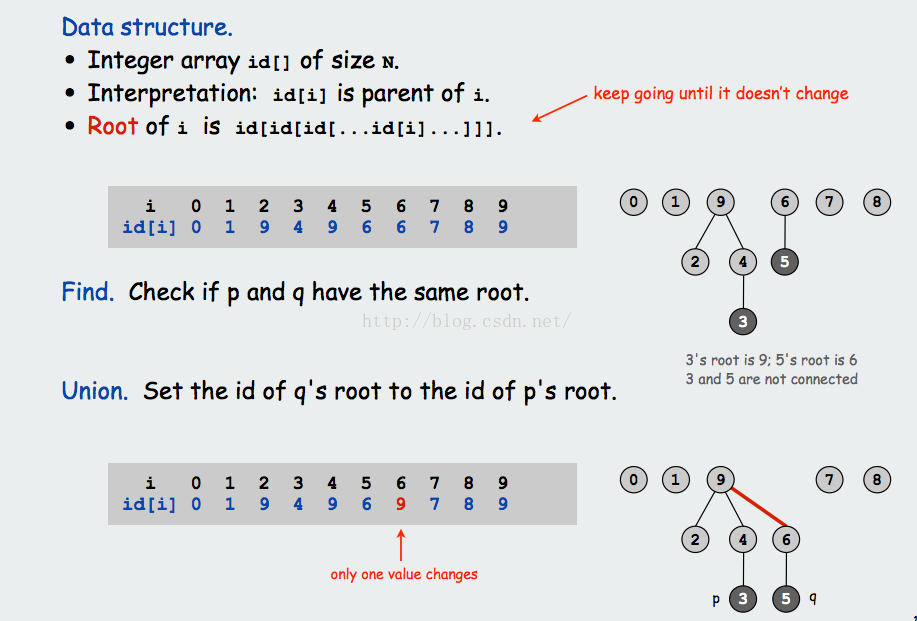
struct Solution {
bool validTree(int n, vector<vector<int>>& edges) {
vector<int> bo(n, -1);
for (auto a : edges) {
int x = find(bo, a[0]), y = find(bo, a[1]);
if (x == y) return false;
bo[x] = y; // merge
}
return edges.size() == n - 1;
}
int find(vector<int> &bo, int i) {
while (bo[i] != -1) i = bo[i];
return i;
}
};如果没有告诉Vertex number n, the only input is edges, we need to count it using a set.
这道题告诉我们如何用union find判断是否有环.
类似: graph.html#number-of-connected-components-in-an-undirected-graph
20.2.1 Java
- DFS
class Solution {
public boolean validTree(int n, int[][] edges) { //DFS
List<List<Integer>> adjList = new ArrayList<>();
for (int i=0; i<n; ++i) { adjList.add(new ArrayList<Integer>()); }
for (int[] edge: edges) {
adjList.get(edge[0]).add(edge[1]);
adjList.get(edge[1]).add(edge[0]);
}
boolean[] visited = new boolean[n];
if (dfs(-1, 0, visited, adjList)) { return false; } // has cycle
for (boolean v: visited) { if (!v) { return false; } }
return true;
}
private boolean dfs(int pred, int vertex, boolean[] visited,
List<List<Integer>> adjList)
{
visited[vertex] = true; // current vertex is being visited
for (Integer succ: adjList.get(vertex)) { // successors of current vertex
if (succ != pred) { // exclude current vertex's predecessor
if (visited[succ]) { return true; } // back edge/loop detected!
if (dfs(vertex, succ, visited, adjList)) { return true; }
}
}
return false;
}
}- BFS
public class GraphValidTree {
//Check 2 things:
//1. whether there is loop
//2. whether the number of connected components is 1
public boolean validTree(int n, int[][] edges) { //BFS
int[] visited = new int[n];
List<List<Integer>> adjList = new ArrayList<>();
for (int i=0; i<n; ++i) { adjList.add(new ArrayList<Integer>()); }
for (int[] edge: edges) {
adjList.get(edge[0]).add(edge[1]);
adjList.get(edge[1]).add(edge[0]);
}
Deque<Integer> q = new ArrayDeque<>();
q.addLast(0); visited[0] = 1; // vertex 0 is in the queue, being visited
while (!q.isEmpty()) {
Integer cur = q.removeFirst();
for (Integer succ: adjList.get(cur)) {
if (visited[succ] == 1) { return false; } // loop detected
if (visited[succ] == 0) { q.addLast(succ); visited[succ] = 1; }
}
visited[cur] = 2; // visit completed
}
// # of connected components is not 1
for (int v: visited) { if (v == 0) { return false; } }
return true;
}
}20.3 BFS (Single/Double/Multiple Sources)
BFS is normally implemented in a iterative way, but it can be done in recursive way too! (see Word Ladder II)
In iterative BFS, queue is the core data structure. In recursive BFS,….
20.4 Walls and Gates (MS-BFS)
You are given a m x n 2D grid initialized with these three possible values.
-1 - A wall or an obstacle.
0 - A gate.
INF - Infinity means an empty room.
We use the value 2^{31} - 1 = 2147483647 to represent INF as
you may assume that the distance to a gate is less than 2147483647.Fill each empty room with the distance to its nearest gate. If it is impossible to reach a gate, it should be filled with INF.
For example, given the 2D grid:
INF -1 0 INF
INF INF INF -1
INF -1 INF -1
0 -1 INF INFAfter running your function, the 2D grid should be:
3 -1 0 1
2 2 1 -1
1 -1 2 -1
0 -1 3 4This is pretty much like BBFS(bi-directional BFS).(Page 109 CC189.) Actually it is the simplest version of multi-source-BFS problem.
http://leetcode.com/problems/walls-and-gates/
Here is how to initialize an STL array?
- C++
void wallsAndGates(vector<vector<int>>& rooms) {
if (rooms.empty() or rooms[0].empty()) return;
int INF = 0x7fffffff, R = rooms.size(), C= rooms[0].size();
array<pair<int,int>,4> dirs{{{-1,0}, {0,-1}, {0, 1}, {1,0}}};
queue<pair<int,int>> Q;
for(int i=0;i<R;++i)
for(int j=0;j<C;++j)
if(0==rooms[i][j]) Q.push({i,j});
while(!Q.empty()){
auto h = Q.front(); Q.pop();
int x(h.first), y(h.second);
for(int k=0;k<dirs.size();++k){
int nx(x+dirs[k].first), ny(y+dirs[k].second);
if (0<=nx and nx<R and 0<=ny and ny<C and rooms[nx][ny]==INF){
rooms[nx][ny] = rooms[x][y] + 1; //update
Q.push({nx, ny});
}
}
}
}- Java
public class Solution {
public void wallsAndGates(int[][] rooms) {
if (rooms.length == 0 || rooms[0].length == 0) return;
Queue<int[]> queue = new LinkedList<>();
for (int i = 0; i < rooms.length; i++) {
for (int j = 0; j < rooms[0].length; j++) {
if (rooms[i][j] == 0) queue.add(new int[]{i, j});
}
}
while (!queue.isEmpty()) {
int[] top = queue.remove();
int row = top[0], col = top[1];
if (row > 0 && rooms[row - 1][col] == Integer.MAX_VALUE) {
rooms[row - 1][col] = rooms[row][col] + 1;
queue.add(new int[]{row - 1, col});
}
if (row < rooms.length - 1 && rooms[row + 1][col] == Integer.MAX_VALUE) {
rooms[row + 1][col] = rooms[row][col] + 1;
queue.add(new int[]{row + 1, col});
}
if (col > 0 && rooms[row][col - 1] == Integer.MAX_VALUE) {
rooms[row][col - 1] = rooms[row][col] + 1;
queue.add(new int[]{row, col - 1});
}
if (col < rooms[0].length - 1 &&
rooms[row][col + 1] == Integer.MAX_VALUE)
{
rooms[row][col + 1] = rooms[row][col] + 1;
queue.add(new int[]{row, col + 1});
}
}
}
}Three ways to traverse a matrix:
Double for loop,BFS,DFS.
20.5 127. Word Ladder
Given two words (beginWord and endWord), and a dictionary’s word list, find the length of shortest transformation sequence from beginWord to endWord, such that:
Only one letter can be changed at a time.
Each transformed word must exist in the word list. Note that beginWord is not a transformed word.
For example,
Given:
beginWord = “hit”
endWord = “cog”
wordList = [“hot”,“dot”,“dog”,“lot”,“log”,“cog”]
As one shortest transformation is “hit” -> “hot” -> “dot” -> “dog” -> “cog”, return its length 5.
Note:
Return 0 if there is no such transformation sequence.
All words have the same length.
All words contain only lowercase alphabetic characters.
You may assume no duplicates in the word list.
You may assume beginWord and endWord are non-empty and are not the same. https://leetcode.com/problems/word-ladder/
https://leetcode.com/problems/word-ladder/
http://bangbingsyb.blogspot.com/2014/11/leetcode-word-ladder-i-ii.html
When using
mapto represent an (un)directed graph, you need to call \(insert()\)twice!!
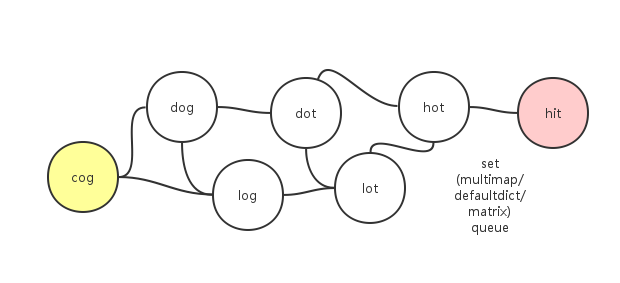
Recently, leetcode changed the signature of the function.
unordered_set<string> wordList;
wordList.insert(beginWord); //that beginWord is not a transformed word
for_each(wl.begin(), wl.end(), [&wordList](string& s){wordList.insert(s);});20.5.1 BFS
传统的老实方法. leetcode的旧的signature(unordered_set<string>& wordList),注意当word数量N大于52=2x26个的时候strategy 2要快些.
struct Solution { // Runtime: 600 ms. Your runtime beats 13.28% of cppsubmissions.
unordered_map<string, unordered_set<string>> G;
// strategy 1 when N<26
bool help1(const string& a, const string& b){
if (a.size()!=b.size()) return false;
int count = 0;
for(int i=0; i<a.size(); ++i) // O(L) L - length of word
if (a[i]!=b[i]){count++; if(count>1) return false;}
return count==1;
}
void make_graph1(const unordered_set<string>& wordList){ // O(L*(N^2)/2)
for (const string& s: wordList)
for (const string& s2: wordList)
if(s!=s2 && (G.count(s)&&G[s]!=s2) && help1(s,s2)) ////
G[s].insert(s2),G[s2].insert(s);
}
// strategy 2 when N>26
void make_graph(const unordered_set<string>& wordList) { //3. O(26*N*L)
for (const string& t : wordList) { // N
string s;
for (int i = 0; i<t.size(); ++i) // L
for (s = t, s[i] = 'a'; s[i]<='z'; ++s[i]) // 26
if (s != t && wordList.count(s))
G[t].insert(s), G[s].insert(t);
}
}
int ladderLength(string beginWord, string endWord,
unordered_set<string>& wordList){
make_graph(wordList);
queue<pair<string, int>> Q;
unordered_set<string> visited; //optional
Q.push({beginWord, 1}), visited.insert(beginWord);
int count = 0;
while(!Q.empty()){ // BFS with undirected graph
auto pr = Q.front(); Q.pop();
if (pr.first == endWord) return pr.second;
for(string t: G[pr.first]){
if (visited.count(t)) continue;
Q.push({t, pr.second+1}), visited.insert(t);
}
}
return 0;
}
};2017年之后leetcode改动了函数的signature, 程序accordingly becomes to the following:
struct Solution { // Runtime: 296 ms. Your runtime beats 43.28% of cppsubmissions.
unordered_map<string, unordered_set<string>> G;
bool help1(const string& a, const string& b){
//if (a.size()!=b.size()) return false; //All words have the same length.
int count = 0;
for(int i=0; i<a.size(); ++i) // O(L) L - length of word
if (a[i]!=b[i]){count++; if(count>1) return false;}
return count==1;
}
void make_graph(const vector<string>& w){ // O(L*(N^2)/2)
for (int i=0;i<w.size();++i)
for (int j=i+1;j<w.size();++j)
if(help1(w[i],w[j])) G[w[i]].insert(w[j]),G[w[j]].insert(w[i]);
}
int ladderLength(string beginWord, string endWord, vector<string>& wl){
wl.push_back(beginWord);//
make_graph(wl);
unordered_set<string> ws;//
for_each(wl.begin(), wl.end(), [&ws](string& s){ws.insert(s);});//
queue<pair<string, int>> Q;
unordered_set<string> visited;
Q.push({beginWord, 1}), visited.insert(beginWord);
int count = 0;
while(!Q.empty()){ // BFS with undirected graph
auto pr = Q.front(); Q.pop();
if (pr.first == endWord) return pr.second;
for(const string& t: G[pr.first]){
if (visited.count(t)) continue;
Q.push({t, pr.second+1}), visited.insert(t);
}
}
return 0;
}
};20.5.2 BFS by Level with optimization
- No graph building, just finding neighbours on the fly.
- No
visitedset, just reusewordList
通常在traverse的时候我们要用一个visited set来keep track of visited nodes,这里我们用了一个小trick就是直接把node删除.
// Runtime: 216 ms. Your runtime beats 79.58% of cppsubmissions. T: O(NL) S: O(N)
struct Solution {
int ladderLength(string beginWord, string endWord, vector<string>& wl) {
unordered_set<string> wordList;
for_each(wl.begin(), wl.end(), [&wordList](const string& s){wordList.insert(s);});
queue<string> q;
q.push(beginWord);
int distance = 1;
while (!q.empty() && distance++){ // N
int count = q.size();
while(count--){// bfs by level
const string word=q.front(); q.pop();
for (int i = 0; i < word.size(); i++){// L
string t(word);
for (t[i]='a'; t[i]<='z'; ++t[i]){ // 26
if (word[i] != t[i]){
if (wordList.count(t)){
if (t == endWord) return distance;
q.push(t), wordList.erase(t);
}
}
}
}
}
}
return 0;
}
};注意这里还有个优化就是通过q.size()得到当前层所有的点数n,然后弹出(pop) n次之后,层数就加一.
20.5.3 Bi-Directional BFS
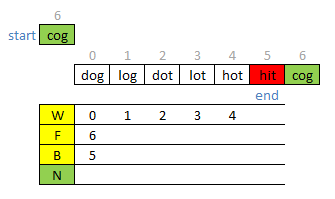
这是本题的最优解.To use two hash tables to build paths from beginWord and endWord relatively.
struct Solution { // Runtime: 56 ms. Your runtime beats 99.11% of cppsubmissions.
int ladderLength(string beginWord, string endWord, unordered_set<string>& W) {
unordered_set<string> F, B, N;
F.insert(beginWord), B.insert(endWord), W.erase(beginWord), W.erase(endWord);
int distance = 1;
while (!F.empty() && !B.empty()){
distance++, N.clear();
if (F.size()>B.size()) swap(F, B);
for (const string& word: F){
for (int i = 0; i < word.size(); i++){
string t(word);
for (t[i] = 'a'; t[i] <= 'z'; t[i]++){
if (word[i] == t[i]) continue;
if (B.count(t))
return distance;
else if (W.count(t))
N.insert(t), W.erase(t);
}
}
}
F = N; // continue searching with N and B
}
return 0;
}
};改了signature之后的版本1:
struct Solution { // 99%
int ladderLength(string beginWord, string endWord, vector<string>& ws) {
unordered_set<string> F={beginWord},B={endWord},N, W(ws.begin(), ws.end());
if(W.count(endWord)==0) return 0;
W.erase(endWord);
int count=1; //
while(!F.empty()){
for(const string& w: F){
for(int i=0;i<w.size();++i){
string t(w); //
for(t[i]='a';t[i]!='z';++t[i]){
if(t[i]==w[i]) continue;
if(B.count(t)) return count+1;
else if(W.count(t)) N.insert(t), W.erase(t);
}
}
}
F=N, N.clear(), count++;
if(F.size()>B.size()) swap(F,B);
}
return 0;
}
};改了signature之后的版本2, 找neighbour的方法不同:
struct Solution { // 53 ms
//int count=0;
bool neighbor(const string& a, const string& b){
//count++; cout << a << "," << b << endl;
int count = 0;
for(int i=0; i<a.size(); ++i) // O(L) L - length of word
if (a[i]!=b[i]){count++; if(count>1) return false;}
return count==1;
}
int ladderLength(string beginWord, string endWord, vector<string>& wl) {
unordered_set<int> F, B, N, W;
int eidx=-1;// index of end word
for(int i=0;i<wl.size();++i){if(endWord!=wl[i]) W.insert(i);else eidx=i;}
if(eidx<0) return 0;
//什么时候erase word(只要在F,B里面的就不应该在W里面)
wl.push_back(beginWord);
F.insert(wl.size()-1), B.insert(eidx);
int distance = 1;
while (!F.empty() && !B.empty()){
++distance, N.clear();
if (F.size()>B.size()) swap(F, B);
for (int k: F){
for (int i: B) if(neighbor(wl[k],wl[i])) return distance;
for (int i: W) if(neighbor(wl[k],wl[i])) N.insert(i);
}
for(int i: N){/* cout <<i<<',' ; */W.erase(i);}// cout << endl;
F = N; // continue searching with N and B
} //cout << count << endl;
return 0;
}
};不同:1. 用int代表vector里面的string, 2. loop vector to find negihbours
20.6 433. Minimum Genetic Mutation
A gene string can be represented by an 8-character long string, with choices from “A”, “C”, “G”, “T”.
Suppose we need to investigate about a mutation (mutation from “start” to “end”), where ONE mutation is defined as ONE single character changed in the gene string.
For example, “AACCGGTT” -> “AACCGGTA” is 1 mutation.
Also, there is a given gene “bank”, which records all the valid gene mutations. A gene must be in the bank to make it a valid gene string.
Now, given 3 things - start, end, bank, your task is to determine what is the minimum number of mutations needed to mutate from “start” to “end”. If there is no such a mutation, return -1.
Note:
Starting point is assumed to be valid, so it might not be included in the bank.
If multiple mutations are needed, all mutations during in the sequence must be valid.
You may assume start and end string is not the same.Example 1:
start: "AACCGGTT"
end: "AACCGGTA"
bank: ["AACCGGTA"]
return: 1
Example 2:
start: "AACCGGTT"
end: "AAACGGTA"
bank: ["AACCGGTA", "AACCGCTA", "AAACGGTA"]
return: 2
Example 3:
start: "AAAAACCC"
end: "AACCCCCC"
bank: ["AAAACCCC", "AAACCCCC", "AACCCCCC"]
return: 320.7 126. Word Ladder II
Given two words (beginWord and endWord), and a dictionary’s word list, find all shortest transformation sequence(s) from beginWord to endWord, such that:
- Only one letter can be changed at a time
- Each transformed word must exist in the word list. Note that beginWord is not a transformed word.
For example, Given:
beginWord = “hit”
endWord = “cog”
wordList = [“hot”,“dot”,“dog”,“lot”,“log”,“cog”]
Return
[
[“hit”,“hot”,“dot”,“dog”,“cog”],
[“hit”,“hot”,“lot”,“log”,“cog”]
]
Note:
Return an empty list if there is no such transformation sequence.
All words have the same length.
All words contain only lowercase alphabetic characters.
You may assume no duplicates in the word list.
You may assume beginWord and endWord are non-empty and are not the same.
UPDATE (2017/1/20):
The wordList parameter had been changed to a list of strings (instead of a set of strings). Please reload the code definition to get the latest changes.
 https://leetcode.com/problems/word-ladder-ii/
https://leetcode.com/problems/word-ladder-ii/
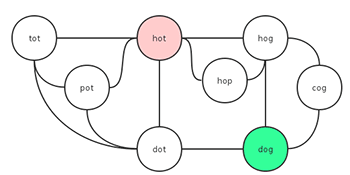
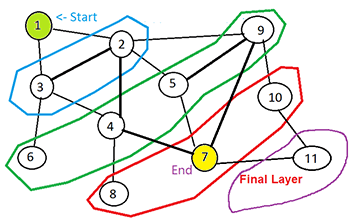
// Runtime: 688 ms
struct Solution {
unordered_map<string, unordered_set<string>> G;//1. Graph
unordered_map<string, unordered_set<string>> P;//2. Path
void make_graph(const unordered_set<string>& wordList) { //3. O(26*N*L)
for (const string& t : wordList) { // N
string s;
for (int i = 0; i<t.size(); ++i) // L
for (s = t, s[i] = 'a'; s[i] <= 'z'; ++s[i]) // 26
if (s != t && wordList.count(s))
G[t].insert(s), G[s].insert(t);
}
}
using VVS = vector<vector<string>>;
VVS findLadders(string beginWord, string endWord, unordered_set<string> &wordList) {
make_graph(wordList);
queue<pair<string, int>> Q; // 4. BFS
unordered_set<string> V, N;// 5. visited and next layer visited
Q.push({ beginWord,1 }), V.insert(beginWord);
int last = -1, curlevel = 1;
while (!Q.empty()) { // 6. BFS
auto t = Q.front(); Q.pop();
// add all nodes in current last, nodes must point to NEXT layer!
if (curlevel != t.second)// 7. At the beginning of a new layer
curlevel = t.second, V.insert(N.begin(), N.end()), N.clear();
if (t.first == endWord)
last = t.second;
else {
if (last>0 && last <= t.second) continue;// 8. optimization
for (const string& s : G[t.first]) {// neighbours
if (V.count(s) == 0) { // 9. cannot be previous layers' nodes
if (N.count(s) == 0) // 10. shouldn't push duplicates into Q
Q.push({ s, t.second + 1 }), N.insert(s);
P[t.first].insert(s);// 11. Record paths
}
}
}
}
VVS r;
if (last<0) return r;// 12. no valid path
vector<string> p;
p.reserve(last), p.push_back(beginWord);
dfs(beginWord, endWord, r, p, last, 1);// 13. DFS to find paths
return r;
}
void dfs(string cur, string& endWord, VVS& r, vector<string>& p, int last, int l) {
if (last == l) {
if (cur == endWord) r.push_back(p);
return;
}
for (auto s : P[cur]) {
if (find(p.begin(), p.end(), s) == p.end()) {// 14. no duplicate nodes in path
p.push_back(s);
dfs(s, endWord, r, p, last, l + 1);
p.pop_back(); // backtrack
}
}
}
};20.7.1 Optmization
- \(make\_graph(.)\) is unnecessary. Imagine beginWord and endWord are negihbours in a huge graph. This speeds up the program a lot!
// Runtime: 444 ms
struct Solution {
unordered_map<string, unordered_set<string>> P;//Path
using VVS = vector<vector<string>>;
VVS findLadders(string beginWord, string endWord, unordered_set<string> &wordList) {
VVS r;
vector<string> p;
queue<pair<string, int>> Q;
unordered_set<string> V, N;// visited and next layer visited
Q.push({ beginWord,1 }), V.insert(beginWord);
int last = -1, curlevel = 1;
while (!Q.empty()) {
auto t = Q.front(); Q.pop();
// add all nodes in current last, nodes must point to NEXT layer!
if (curlevel != t.second)
curlevel = t.second, V.insert(N.begin(), N.end()), N.clear();
if (t.first != endWord) {
if (last>0 && last <= t.second) continue;
string s = t.first;
for (int i = 0; i<s.size(); ++i) { // L
s = t.first;
for (s[i] = 'a'; s[i] <= 'z'; ++s[i]) { // 26
if (s[i] != t.first[i] && wordList.count(s))
if (V.count(s) == 0) {
if (!N.count(s)) Q.push({ s,t.second + 1 }), N.insert(s);
P[t.first].insert(s);
}
}
}
} else last = t.second;
}
if (last<0) return r;
p.reserve(last), p.push_back(beginWord);
dfs(beginWord, endWord, r, p, last, 1);
return r;
}
void dfs(string cur, string& endWord, VVS& r, vector<string>& p, int last, int l) {
if (last == l && cur == endWord) {
r.push_back(p);
return;
}
if (last <= l) return;
for (auto s : P[cur]) {
if (find(p.begin(), p.end(), s) == p.end()) {
p.push_back(s);
dfs(s, endWord, r, p, last, l + 1);
p.pop_back();
}
}
}
};- Layer Marker with a Dummy Node
Here we use a dummy node(empty string) to mark the end of a layer. This won’t speed up the program a lot, but it saves more space, and makes code more concise.
// Runtime: 468 ms
struct Solution {
unordered_map<string, unordered_set<string>> PA;//Path
using VVS = vector<vector<string>>;
VVS findLadders(string beginWord, string endWord, unordered_set<string> &wordList) {
VVS r;
vector<string> p;
queue<string> Q;
unordered_set<string> V, N;// visited and next layer visited
Q.push(beginWord), Q.push(""), V.insert(beginWord);
int last = -1, curlevel = 1;
while (!Q.empty()) {
auto t = Q.front(); Q.pop();
// add all nodes in current last, nodes must point to NEXT layer!
if (t != endWord) {
if (last>0 && last <= curlevel) continue;
for (int i = 0; i<t.size(); ++i) { // L
string s = t;
for (s[i] = 'a'; s[i] <= 'z'; ++s[i]) { // 26
if (s != t && wordList.count(s))
if (V.count(s) == 0) {
if (!N.count(s)) Q.push(s), N.insert(s);
PA[t].insert(s);
}
}
}
} else last = curlevel;
if (t.empty() && !Q.empty())
++curlevel, V.insert(N.begin(), N.end()), N.clear(), Q.push("");
}
if (last<0) return r;
p.reserve(last), p.push_back(beginWord);
dfs(beginWord, endWord, r, p, last, 1);
return r;
}
void dfs(string cur, string& endWord, VVS& r, vector<string>& p, int last, int l) {
if (last == l && cur == endWord) {
r.push_back(p);
return;
}
if (last <= l) return;
for (auto s : PA[cur]) {
if (find(p.begin(), p.end(), s) == p.end()) {
p.push_back(s);
dfs(s, endWord, r, p, last, l + 1);
p.pop_back();
}
}
}
};- Visited Set
// Runtime: 432 ms
VVS findLadders(string beginWord, string endWord, unordered_set<string> &wordList) {
VVS r;
vector<string> p;
queue<pair<string, int>> Q;
// prev, current and next layer visited
unordered_set<string> PrevLayer, CurrLayer, NextLayer;
unordered_set<string>* P = &PrevLayer, *C = &CurrLayer, *N = &NextLayer;
Q.push({ beginWord,1 }), C->insert(beginWord);
int last = -1, curlevel = 1;
while (!Q.empty()) {
auto t = Q.front(); Q.pop();
if (curlevel != t.second) {
auto tmp = P;
P->clear(), P = C, C = N, N = tmp, curlevel = t.second;
}
if (t.first != endWord) {
if (last>0 && last <= t.second) continue;
for (int i = 0; i<t.first.size(); ++i) { // L
string s = t.first;
for (s[i] = 'a'; s[i] <= 'z'; ++s[i]) { // 26
if (s[i] != t.first[i] && wordList.count(s))
if (C->count(s) == 0 && P->count(s) == 0) {
if (!N->count(s)) Q.push({ s,t.second + 1 }), N->insert(s);
PA[t.first].insert(s);
}
}
}
} else last = t.second;
}
if (last<0) return r;
p.reserve(last), p.push_back(beginWord);
dfs(beginWord, endWord, r, p, last, 1);
return r;
}- Double Source BFS

Walls and Gates is a multi-srouce BFS problem. Here we can use bouble-source BFS to optimize our program.
注意BFS返回bool.
struct Solution{//Bidirectional BFS+DFS.Runtime:76 ms.Your runtime beats 97.94%...
#define CONNECT(s, t, b) PA[b?s:t].insert(b?t:s)
using VVS = vector<vector<string>>;
using USS = unordered_set<string>;
unordered_map<string, unordered_set<string>> PA;
// f用来表示方向forward, build path的时候用
bool bfs(USS &F, USS &B, bool f, USS &W) {
if (F.empty() || B.empty()) return false;
if (F.size() > B.size()) // always do bfs with less nodes
return bfs(B, F, !f, W);
for (const string& s : F) W.erase(s);
for (const string& s : B) W.erase(s);
USS N;
bool isConnected = false;
for (const string& word : F) {
for (int i = 0; i < word.size(); i++) {
string str(word);
for (str[i] = 'a'; str[i] <= 'z'; str[i]++)
if (word[i] != str[i])
if (B.count(str))
isConnected = true, CONNECT(word, str, f);
else if (!isConnected && W.count(str)) ////
N.insert(str), CONNECT(word, str, f);
}
}
if (isConnected)
return true;
else
return bfs(N, B, f, W);
}
void dfs(VVS &r, vector<string> &path, string &curWord, string &endWord) {
path.push_back(curWord);
if (curWord == endWord) r.push_back(path);
else
for (string nextWord : PA[curWord]) dfs(r, path, nextWord, endWord);
path.pop_back();
}
VVS findLadders(string beginWord, string endWord, USS &W) {
VVS r;
vector<string> path;
USS F, B;
F.insert(beginWord), B.insert(endWord);
if (bfs(F, B, true, W))
dfs(r, path, beginWord, endWord);
return r;
}
};http://www.1point3acres.com/bbs/forum.php?mod=viewthread&tid=213577
见过不少面经提到被问到1.5版本,就是只输出一条最短路径,同时还被challenge用26个字符iteration太慢,想问问大家怎么回答这个follow up 的?
如果只需要find one shortest path, 那么就比较简单了这里:
20.8 Number of Connected Components in an Undirected Graph
Given n nodes labeled from 0 to n - 1 and a list of undirected edges (each edge is a pair of nodes), write a function to find the number of connected components in an undirected graph.
Example 1:
0 3
| |
1 --- 2 4
Given n = 5 and edges = [[0, 1], [1, 2], [3, 4]], return 2.
Example 2:
0 4
| |
1 --- 2 --- 3Given n = 5 and edges = [[0, 1], [1, 2], [2, 3], [3, 4]], return 1.
Note:
You can assume that no duplicate edges will appear in edges. Since all edges are undirected, [0, 1] is the same as [1, 0] and thus will not appear together in edges.
 https://leetcode.com/problems/number-of-connected-components-in-an-undirected-graph
https://leetcode.com/problems/number-of-connected-components-in-an-undirected-graph
http://buttercola.blogspot.com/2016/01/leetcode-number-of-connected-components.html
class Solution {
vector<int> bo, sz;
void makeset(int n){
bo.resize(n);
iota(bo.begin(), bo.end(), 0);
sz.resize(n);
fill(sz.begin(),sz.end(), 1);
}
int findset(int i){
if(i != bo[i]) return bo[i]=findset(bo[i]);
return bo[i];
}
void merge(int i, int j){
int b1=findset(i), b2=findset(j);
if(b1==b2) return;
int sma = sz[b1]>sz[b2] ? b2 : b1;
int big = sz[b1]>sz[b2] ? b1 : b2;
bo[sma]=big, sz[big]+=sz[sma], sz[sma]=0;
}
public:
int countComponents(int n, vector<pair<int, int>>& edges) {
makeset(n);
for(auto pr : edges)
merge(pr.first, pr.second);
return count_if(sz.begin(), sz.end(), [](int i){return i>0;});
}
};为什么叫动态联通(Dynamic Connectivity),因为merge的过程就是把小图联通成大图的过程.
小知识点:
1. http://stackoverflow.com/questions/15292892/what-is-return-type-of-assignment-operator
2. greater是一个binary operator,用在这里的话必须用bind:
关于复杂度, 参考阅读: http://www.cnblogs.com/SeaSky0606/p/4752941.html
20.9 684. Redundant Connection
We are given a “tree” in the form of a 2D-array, with distinct values for each node.
In the given 2D-array, each element pair [u, v] represents that v is a child of u in the tree.
We can remove exactly one redundant pair in this “tree” to make the result a tree.
You need to find and output such a pair. If there are multiple answers for this question, output the one appearing last in the 2D-array. There is always at least one answer.
Example 1:
Input: [[1,2], [1,3], [2,3]]
Output: [2,3]
Explanation: Original tree will be like this:
1
/ \
2 - 3Example 2:
Input: [[1,2], [1,3], [3,1]]
Output: [3,1]
Explanation: Original tree will be like this:
1
/ \\
2 3Note:
The size of the input 2D-array will be between 1 and 1000.
Every integer represented in the 2D-array will be between 1 and 2000.
https://leetcode.com/problems/redundant-connection/
Algo: Union find
class Solution {
public:
vector<int> findRedundantConnection(vector<vector<int>>& edges) {
int i,j,k,n,x,y,tmp,mx;
for(auto e:edges)
mx=max(*max_element(e.begin(), e.end()), mx);
vector<int> p(++mx);
iota(p.begin(), p.end(), 0); //0,1,2,3...
for (i=0;i<edges.size();i++){
x=edges[i][0], y=edges[i][1];
if (p[x]==p[y]) // connected
return edges[i];
tmp=p[y];
for (j=0;j<mx;j++) //merge
if (p[j]==tmp)
p[j]=p[x];
}
return {};
}
};- JAVA
class Solution {
public int[] findRedundantConnection(int[][] edges) {
int[] parent = new int[2001];
for (int i = 0; i < parent.length; i++)
parent[i] = i;
for (int[] edge: edges){
int f = edge[0], t = edge[1];
if (find(parent, f) == find(parent, t)) return edge;
else parent[find(parent, f)] = find(parent, t);
}
return new int[2];
}
private int find(int[] parent, int f) {
if (f != parent[f]) {
parent[f] = find(parent, parent[f]);
}
return parent[f];
}
}20.11 Longest Path
CLRS P404, P1048
NP Hard http://stackoverflow.com/questions/21880419/how-to-find-the-longest-simple-path-in-a-graph
20.12 Expression Add Operators (DFS + Pruning)
Given a string that contains only digits 0-9 and a target value, return all possibilities to add binary operators (not unary) +, -, or * between the digits so they evaluate to the target value.
Examples:
"123", 6 -> ["1+2+3", "1*2*3"]
"232", 8 -> ["2*3+2", "2+3*2"]
"105", 5 -> ["1*0+5","10-5"]
"00", 0 -> ["0+0", "0-0", "0*0"]
"3456237490", 9191 -> [] https://leetcode.com/problems/expression-add-operators/
https://leetcode.com/problems/expression-add-operators/
Based on subsets but the algo is even more complicated.
In the for loop of
subsets, there is only one recursive call. But in this problem, there are three.Pruning:
if (cur.size() > 1 && cur[0] == '0') return;Considering
1+2*3, we need to save previous value to the stack asd. The dfs for multiplication is:dfs(n, target, d*t, (c-d)+d*t, p+"*"+cur, res);
http://www.cnblogs.com/grandyang/p/4814506.html
struct Solution {
vector<string> addOperators(string num, int target) {
vector<string> res;
dfs(num, target, 0, 0, "", res);
return res;
}
void dfs(string& num, int target, int d, long c, string p, vector<string> &res){
if (num.empty() && c==target)
res.push_back(p);
for (int i=1; i<=num.size(); ++i) {
string cur = num.substr(0, i);
if (cur.size()>1 && cur[0]=='0')
return;
string n = num.substr(i);
long t = stoll(cur);
if (p.empty())
dfs(n, target, t, t, cur, res);
else {
dfs(n, target, t, c+t, p+"+"+cur, res);
dfs(n, target, -t, c-t, p+"-"+cur, res);
dfs(n, target, d*t, (c-d)+d*t, p+"*"+cur, res);
}
}
}
};20.13 Route Tracking
If you want to track the routes, you have to add more stuff in the stack: final_result, partial_solution etc
 https://leetcode.com/problems/word-search/
https://leetcode.com/problems/word-search/
 https://leetcode.com/problems/letter-combinations-of-a-phone-number/
https://leetcode.com/problems/letter-combinations-of-a-phone-number/
20.14 Kangroo Jump
There are two types of kangroos, left learning(<) and right learning(>) ones. Six kangroos are initially arranged on seven slots in the following configration:
[>,>,>,_,<,<,<]
The empty slot is indicated by ’_’ and the task is to move all the kangaroos on the left to the right and all the kangroos on the right to the left, as in:
[<,<,<,_,>,>,>]
The rules are simple:
1. a right leaning kangaroo can only move to the right, left kangroo only left
2. a kangroo can either move one step forward to fill an empty slot or jump over any one kangroo to occupy an empty slot.
Is it possible to perform a sequence of moves to solve the task above?
General speaking, there are 4 possible next steps for any current position, we can use DFS to search path and pruning to speed up.
这道题的难点在于如何pruning.
不失一般性,假设第一步是>>>_><<<<,第二步必然是>>><>_<<<,不可能是>>_>><<<<,否则右边会出现>><,这种形状必然无解.
从第二步>>><>_<<<下一步必然是>>><><_<<,不可能是>>>><_><<<,否则会出现><_><,这种形状也必然无解.也不可能是>>><><<_<,否则左边是><<,必然无解.
><_><的下一步是_<>><或者><<>_.
if (
(k>=2 && !s.compare(k-2,5,"><_><")) ||
(k>=3 && !s.compare(k-3,3,"><<")) ||
(k<len-3 && !s.compare(k+1,3,">><"))
)再往后原因类似,反正每一步可行的决策都是唯一的
其实上面的Pruning并没有剪掉所有的烂枝桠.看下图,上面的逻辑漏掉了情况E.
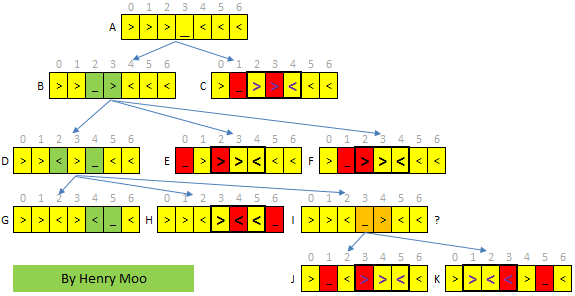
:Explorer:(506256462) 3:28:49 AM
但是对于形如>>>_<<<的数据来说,这个剪枝用不上
:Explorer:(506256462) 4:11:26 AM
有了>><和><<就不用加><_><了
:Explorer:(506256462) 4:11:47 AM
我之前说错了,不只是>>>_<<<,其实在任何数据里,都用不上><_><
:Explorer:(506256462) 4:12:09 AM
我在证明里考虑><_><只是因为可以简化后续证明所以正确的Pruning是下面这样的:
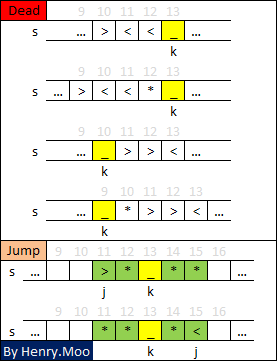
代码实现:
#include <string>
#include <cstdlib>
#include <iostream>
using namespace std;
int v=0;
bool dfs(string& s, int k){
static const int len = s.size();
if ((k>=3 && !s.compare(k-3,3,"><<")) ||
(k>=4 && !s.compare(k-4,3,"><<")) ||
(k<len-3 && !s.compare(k+1,3,">><")) ||
(k<len-4 && !s.compare(k+2,3,">><")))
return false;
if ('_'==s[len/2] && s.find_first_of('>')==len/2+1){
if(v)cout << s << endl;
//if(getchar()==' ') cout << s << endl;
return true;
}
for(int i=-2;i<=2;++i){
int j=k+i;
if ((i==0 || j<0 || j>=len) || (s[j]!=(i<0?'>':'<'))) continue;
swap(s[j],s[k]);
if(dfs(s,j)){
swap(s[k],s[j]);
if(v)cout << s << endl;
return true;
}else swap(s[k],s[j]);
}
return false;
}
int main(int argc, char **argv){
int x=30;
if (argc>=2) x=atoi(argv[1]);
if (argc>=3) v=atoi(argv[2]);
string input=string(x,'>')+"_"+string(x,'<');
if(dfs(input, input.size()/2)){
cout << "path found"<< endl;
}
return 0;
}运行结果:
$ulimit -s unlimited
$time ./kangroo_g 8000
path found
real 0m3.772s
user 0m3.144s
sys 0m0.636s这道题告诉我们,正确的Pruning实在是太重要了.
看看复杂度:
$time ./kangroo_g 10240
path found
real 0m6.183s
user 0m5.208s
sys 0m0.976s
$time ./kangroo_g 5120
path found
real 0m1.574s
user 0m1.284s
sys 0m0.276s
$time ./kangroo_g 2560
path found
real 0m0.411s
user 0m0.336s
sys 0m0.072s
$time ./kangroo_g 1280
path found
real 0m0.112s
user 0m0.088s
sys 0m0.020s
$time ./kangroo_g 640
path found
real 0m0.036s
user 0m0.028s
sys 0m0.004s
$time ./kangroo_g 320
path found
real 0m0.012s
user 0m0.008s
sys 0m0.000s
$time ./kangroo_g 160
path found
real 0m0.011s
user 0m0.008s
sys 0m0.000s数据量是原来2倍的时候,时间是原来的4倍.数据量太小的时候,算法不占主因,看不出来.一边袋鼠300只以上就可以看得出来了.
复杂度: T:\(O(N^2)\), S:\(O(N^2)\)
到达目标的步数是单边袋鼠数量+1的平方.
Ocaml Code:
(* Kangroo jump problem solution *)
(* April/02/2017 *)
(* T:O(N^2), S:O(N^2) *)
let rec dfs str idx len =
let alive s i len = (* make sure there is no dead kangroo *)
(i<3 || (s.[i-1]!='<'||s.[i-2]!='<' || s.[i-3]!='>')) &&
(i<4 || (s.[i-2]!='<'||s.[i-3]!='<' || s.[i-4]!='>')) &&
(i>=len-3 || (s.[i+1]!='>' || s.[i+2]!='>' || s.[i+3]!='<')) &&
(i>=len-4 || (s.[i+2]!='>' || s.[i+3]!='>' || s.[i+4]!='<')) in
let swap s i j = let t=s.[i] in (Bytes.set s i s.[j]; Bytes.set s j t; s) in
if (str.[len/2]=='_' && not (String.rcontains_from str (len/2) '>')) then
true (* complete *)
else
let rec moveloop r = (* kangroo moves in this loop *)
match r with
| [] -> false
| (hd :: rest) ->
let candidate = if hd < idx then '>' else '<' in
if hd >= 0 && hd < len && str.[hd] == candidate && (alive str idx len) then
let _ = swap str idx hd in
let viable = (dfs str hd len) in
let _ = swap str idx hd in
if viable then
viable
else moveloop rest
else moveloop rest
in moveloop [idx-2; idx-1; idx+1; idx+2]
;;
let jump str = let len = String.length str in dfs str (len/2) len in
let input n = String.concat "_" [String.make n '>'; String.make n '<'] in
let knum = if (Array.length Sys.argv) < 2 then 3 else (int_of_string Sys.argv.(1)) in
Printf.printf "%d kangroos -> %B\n" (knum*2) (jump (input knum)) ;;20.15 Topological Sort
http://blog.csdn.net/dm_vincent/article/details/7714519
Concept: degree, in-degree, out-degree
Kahn’s Algorithm (BFS)
The advantage of Kahn’ algo isDAG checkingis not need.DFS
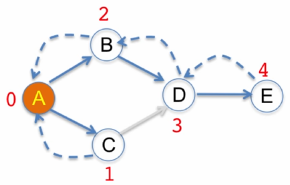
DAG checking must be done or the DFS will go into a infinite loop.
T: \(O(|V| + |E|)\), S: \(O(|E|)\)
20.16 Course Schedule - Khan BFS(1 set+2 maps)
There are a total of n courses you have to take, labeled from 0 to n - 1.
Some courses may have prerequisites, for example to take course 0 you have to first take course 1, which is expressed as a pair: [0,1]
Given the total number of courses and a list of prerequisite pairs, is it possible for you to finish all courses?
For example:
2, [[1,0]]
There are a total of 2 courses to take. To take course 1 you should have finished course 0. So it is possible.
2, [[1,0],[0,1]]
There are a total of 2 courses to take. To take course 1 you should have finished course 0, and to take course 0 you should also have finished course 1. So it is impossible.
 https://leetcode.com/problems/course-schedule/
https://leetcode.com/problems/course-schedule/
http://www.cnblogs.com/grandyang/p/4484571.html
https://en.wikipedia.org/wiki/Topological_sorting#Kahn.27s_algorithm
(CLRS p615. 22.4-3)
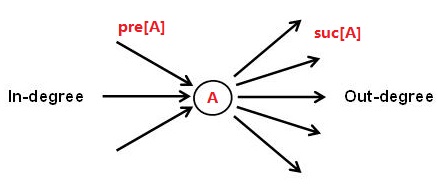
topologically sortable == No cycle!
下面用一个例子在解释Khan’s Algorithm. Example:
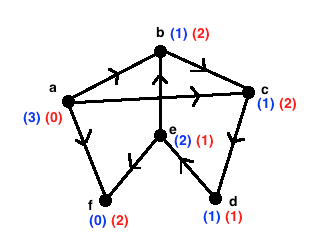
pre[b]=a,e
pre[c]=a,b
pre[d]=c
pre[e]=d
pre[f]=e,a
suc[a]=b,c,f
suc[b]=c
suc[c]=d
suc[d]=e
suc[e]=b,f
ns=a,b,c,d,e,f //all nodes in the graph- 找到0-indegree node: 把pre的key从ns里面删除,ns==[a],里面包含的就是0-indegree nodes(‘a’ in this case).
- 找到0-indegree node: 把pre的key从ns里面删除,ns==[a],里面包含的就是0-indegree nodes(‘a’ in this case).
- 然后从pre和suc里面移除所有a节点: 首先检查suc,找suc[a]里面的点b,c,f,然后找pre[b], pre[c], pre[f],里面肯定都包含有a,把这个a删除,如果剩下为空set,说明又找到一个0-indegree node.
- 然后从pre和suc里面移除所有a节点: 首先检查suc,找suc[a]里面的点b,c,f,然后找pre[b], pre[c], pre[f],里面肯定都包含有a,把这个a删除,如果剩下为空set,说明又找到一个0-indegree node.
- 如此循环,直到ns为空!
- 如此循环,直到ns为空!
- 最后看pre和suc也为空的话,说明是
topologically sortable!!!
- 最后看pre和suc也为空的话,说明是
在这个过程中已经按顺序找到了所有的node,in another words, we have done topological sort.
After removing ‘a’, it becomes:
pre[b]=e
pre[c]=b
pre[d]=c
pre[e]=d
pre[f]=e
suc[b]=c
suc[c]=d
suc[d]=e
suc[e]=b,f
ns=[] // 0-indegree nodes这个ns已经为空了,而pre和suc还不为空,说明不可sort. 的确, b-c-d-e是一个cycle.
下面的参数prerequisites是pre的vector的表示方式. 注意这种表示有向图的方式.
- C++
struct Solution {
bool canFinish(int numCourses, vector<pair<int, int>>& prerequisites) {
unordered_map<int, set<int>> suc, pre;
unordered_set<int> ns;
for (auto p : prerequisites) {
suc[p.second].insert(p.first), pre[p.first].insert(p.second);
ns.insert(p.second); // ns will include all nodes
}
for (auto p : pre) ns.erase(p.first); // leave 0-indegree in ns
while (!ns.empty()) {
unordered_set<int> tmp;
for (int i : ns) {
if (suc.count(i)) {
for (int j : suc[i]) {
if (pre.count(j) == 0) continue;//indegree==0
pre[j].erase(i);
if (pre[j].empty()) {
pre.erase(j);
tmp.insert(j);
}
}
suc.erase(i);
}
}
ns = tmp;
}
return pre.empty() && suc.empty();
}
};这题最好画图说明,算法其实简单但是很绕.
- Java
BFS:
public class Solution { //BFS
public boolean canFinish(int numCourses, int[][] prerequisites) {
//This problem can be converted to finding if a graph contains a cycle.
if(prerequisites == null){
throw new IllegalArgumentException("illegal prerequisites array");
}
int len = prerequisites.length;
if(numCourses == 0 || len == 0){
return true;
}
// counter for number of prerequisites
int[] pCounter = new int[numCourses];
for(int i=0; i<len; i++){
pCounter[prerequisites[i][0]]++;
}
//store courses that have no prerequisites
LinkedList<Integer> queue = new LinkedList<Integer>();
for(int i=0; i<numCourses; i++){
if(pCounter[i]==0){
queue.add(i);
}
}
// number of courses that have no prerequisites
int numNoPre = queue.size();
while(!queue.isEmpty()){
int top = queue.remove();
for(int i=0; i<len; i++){
// if a course's prerequisite can be satisfied by a course in queue
if(prerequisites[i][1]==top){
pCounter[prerequisites[i][0]]--;
if(pCounter[prerequisites[i][0]]==0){
numNoPre++;
queue.add(prerequisites[i][0]);
}
}
}
}
return numNoPre == numCourses;
}
}DFS:
public boolean canFinish(int numCourses, int[][] prerequisites) {
if(prerequisites == null){
throw new IllegalArgumentException("illegal prerequisites array");
}
int len = prerequisites.length;
if(numCourses == 0 || len == 0){
return true;
}
//track visited courses
int[] visit = new int[numCourses];
// use the map to store what courses depend on a course
HashMap<Integer,ArrayList<Integer>> map = new HashMap<>();
for(int[] a: prerequisites){
if(map.containsKey(a[1])){
map.get(a[1]).add(a[0]);
}else{
ArrayList<Integer> l = new ArrayList<Integer>();
l.add(a[0]);
map.put(a[1], l);
}
}
for(int i=0; i<numCourses; i++){
if(!canFinishDFS(map, visit, i))
return false;
}
return true;
}
private boolean canFinishDFS(HashMap<Integer,
ArrayList<Integer>> map, int[] visit, int i)
{
if(visit[i]==-1)return false;
if(visit[i]==1) return true;
visit[i]=-1;
if(map.containsKey(i)){
for(int j: map.get(i)){
if(!canFinishDFS(map, visit, j))
return false;
}
}
visit[i]=1;
return true;
}20.17 Course Schedule II
There are a total of n courses you have to take, labeled from 0 to n - 1.
Some courses may have prerequisites, for example to take course 0 you have to first take course 1, which is expressed as a pair: [0,1]
Given the total number of courses and a list of prerequisite pairs, return the ordering of courses you should take to finish all courses.
 https://leetcode.com/problems/course-schedule-ii/
https://leetcode.com/problems/course-schedule-ii/
(CLRS p615. 22.4-5) 这道题根据pre求DAG里面节点的order. 采用和BFS类似的思想,一层层往里面剥.剥掉一层之后里面紧挨一层的indgree数目就减1.
struct Solution {
vector<int> findOrder(int n, vector<pair<int, int>>& pre) {
vector<int> r;
vector<vector<int>> G(n, r);
vector<int> in(n); ////
for (auto &pr : pre)
G[pr.second].push_back(pr.first), ++in[pr.first];
queue<int> Q; // all nodes with in-degree equal to 0
for(int i=0;i<n;++i)
if(in[i]==0) Q.push(i);
while (!Q.empty()) {
int t = Q.front(); Q.pop();
r.push_back(t);
for (int i : G[t]){ if(--in[i] == 0) Q.push(i); }
}
if(r.size()!= n) return {}; // topologically unsortable
return r;
}
};这道题也是用khan algorithm,这里的G相当于suc, pre就是pre不过表现形式不一样而已.这里也用了queue,而不是set.
这道题变化一下可以考察求出所有可行的课程安排:
vector<vector<int>> r;
while (!Q.empty()) {
int count = Q.size();
vector<int> p;
while (--count) {
int t = Q.front(); Q.pop();
p.push_back(t);
for (int i : G[t]) { if (--in[i] == 0) Q.push(i); }
}
r.push_back(p);
}然后再用Combinatorics DFS的方法求出所有的schedule, like combinatorics.html#letter-combinations-of-a-phone-number-1.
- Java
public int[] findOrder(int numCourses, int[][] prerequisites) {
if(prerequisites == null){
throw new IllegalArgumentException("illegal prerequisites array");
}
int len = prerequisites.length;
//if there is no prerequisites, return a sequence of courses
if(len == 0){
int[] res = new int[numCourses];
for(int m=0; m<numCourses; m++){
res[m]=m;
}
return res;
}
//records the number of prerequisites each course (0,...,numCourses-1) requires
int[] pCounter = new int[numCourses];
for(int i=0; i<len; i++){
pCounter[prerequisites[i][0]]++;
}
//stores courses that have no prerequisites
LinkedList<Integer> queue = new LinkedList<Integer>();
for(int i=0; i<numCourses; i++){
if(pCounter[i]==0){
queue.add(i);
}
}
int numNoPre = queue.size();
//initialize result
int[] result = new int[numCourses];
int j=0;
while(!queue.isEmpty()){
int c = queue.remove();
result[j++]=c;
for(int i=0; i<len; i++){
if(prerequisites[i][1]==c){
pCounter[prerequisites[i][0]]--;
if(pCounter[prerequisites[i][0]]==0){
queue.add(prerequisites[i][0]);
numNoPre++;
}
}
}
}
//return result
if(numNoPre==numCourses){
return result;
}else{
return new int[0];
}
}20.18 332. Reconstruct Itinerary
Given a list of airline tickets represented by pairs of departure and arrival airports [from, to], reconstruct the itinerary in order. All of the tickets belong to a man who departs from JFK. Thus, the itinerary must begin with JFK.
Note:
If there are multiple valid itineraries, you should return the itinerary that has the smallest lexical order when read as a single string. For example, the itinerary [“JFK”, “LGA”] has a smaller lexical order than [“JFK”, “LGB”].
All airports are represented by three capital letters (IATA code).
You may assume all tickets form at least one valid itinerary.
Example 1:
tickets = [["MUC", "LHR"], ["JFK", "MUC"], ["SFO", "SJC"], ["LHR", "SFO"]]
Return ["JFK", "MUC", "LHR", "SFO", "SJC"].Example 2:
tickets = [["JFK","SFO"],["JFK","ATL"],["SFO","ATL"],["ATL","JFK"],["ATL","SFO"]]
Return ["JFK","ATL","JFK","SFO","ATL","SFO"].Another possible reconstruction is [“JFK”,“SFO”,“ATL”,“JFK”,“ATL”,“SFO”]. But it is larger in lexical order.
https://leetcode.com/problems/reconstruct-itinerary/

Note there may be more than one same tickets. For example:
[['ANU', 'EZE'], ['ANU', 'JFK'], ['ANU', 'TIA'], ['AXA', 'TIA'],
['EZE', 'AXA'], ['JFK', 'ANU'], ['JFK', 'TIA'], ['TIA', 'ANU'],
['TIA', 'ANU'], ['TIA', 'JFK']]由于题目中限定了一定会有解,那么等图中所有的multiset中都没有节点的时候,我们把当前节点存入结果中
class Solution {
public:
vector<string> findItinerary(vector<pair<string, string>> tickets) {
map<string,multiset<string>> g;
for(auto pr: tickets)
g[pr.first].insert(pr.second);
vector<string> r;
dfs(g,"JFK",r);
reverse(r.begin(), r.end());
return r;
}
//拓扑排序,本质是图的后序遍历.
void dfs(map<string,multiset<string>>& g, string s, vector<string>& r){
multiset<string>& gs=g[s];
while(!gs.empty()){
string t=*gs.begin();
gs.erase(gs.begin());
dfs(g,t,r);
}
r.push_back(s);
}
};这道题的本质是计算一个最“小”的欧拉路径(Eulerian path).对于一个节点(当然先从JFK开始),贪心地访问最小的邻居,访问过的边全部删除.当碰到死路的时候就回溯到最近一个还有出路的节点,然后把回溯的路径放到最后去访问,这个过程和后序遍历的一样.1. 如果子节点没有死路(每个节点都只左子树),前序遍历便是欧拉路径.2. 如果子节点1是死路,子节点2完成了遍历,那么子节点2先要被访问.1,2都和后序遍历的顺序正好相反.?
20.19 Alien Dictionary
 https://leetcode.com/problems/alien-dictionary/
https://leetcode.com/problems/alien-dictionary/
string alienOrder(vector<string>& words) {
map<char, set<char>> suc, pre;
set<char> chars;
string s;
for (string t : words) {
chars.insert(t.begin(), t.end());
for (int i = 0; i<min(s.size(), t.size()); ++i) {
char a = s[i], b = t[i];
if (a != b) {
suc[a].insert(b), pre[b].insert(a);
break;
}
}
s = t;
}
int count = chars.size();
for (auto p : pre) chars.erase(p.first);
string order;
while (!chars.empty()) {
char a = *begin(chars);
chars.erase(a);
order += a;
for (char b : suc[a]) {
pre[b].erase(a);
if (pre[b].empty()) chars.insert(b);
}
}
return order.size() == count ? order : "";
}给course schedule一模一样,不过这里build suc/pre的方式不一样而已.
20.20 310. Minimum Height Trees
For a undirected graph with tree characteristics, we can choose any node as the root. The result graph is then a rooted tree. Among all possible rooted trees, those with minimum height are called minimum height trees (MHTs). Given such a graph, write a function to find all the MHTs and return a list of their root labels.
Format:
The graph contains n nodes which are labeled from 0 to n - 1. You will be given the number n and a list of undirected edges (each edge is a pair of labels).
You can assume that no duplicate edges will appear in edges. Since all edges are undirected, [0, 1] is the same as [1, 0] and thus will not appear together in edges.
Example 1: Given n = 4, edges = [[1, 0], [1, 2], [1, 3]], return [1].
0
|
1
/ \
2 3Example 2: Given n = 6, edges = [[0, 3], [1, 3], [2, 3], [4, 3], [5, 4]], return [3, 4].
0 1 2
\ | /
3
|
4
|
5https://leetcode.com/problems/minimum-height-trees
这道题与前面不同的是它不是一个DAG,是undirected graph.而且它是树,所以没有环! 所以采用Khan Algo的思想就是剥洋葱! 但是剥到什么时候为止呢? 因为没有环,所以到只剩2个或者1个node的时候结束. 还有如何确定最外层的leaf node呢?上面的方法是找in-degree,那是DAG的用法.对本题的无向树来说,邻居的数目(degree)是1表示是leaf node!
struct Solution {
vector<int> findMinHeightTrees(int n, vector<pair<int, int>>& edg) {
if(n==1) return {0};// edge case of one node
map<int, set<int>> m;
for(auto& pr: edg)
m[pr.first].insert(pr.second), m[pr.second].insert(pr.first);
while(m.size()>2){
set<int> leaves;
auto it=m.begin();
while(it!=m.end())
if(it->second.size()==1)
leaves.insert(it->first), it=m.erase(it);
else it++;
if(m.size()<=2) break;
for(auto& pr: m){ // remove connection
auto it=pr.second.begin();
while(it!=pr.second.end())
if(leaves.count(*it)) it=pr.second.erase(it);
else it++;
}
}
vector<int> r;
for(auto pr: m) r.push_back(pr.first);
return r;
}
};这道题的实现involves到C++中如何在循环中从STL container删除元素. bug多发地段之一.
http://en.cppreference.com/w/cpp/container/set/erase
http://en.cppreference.com/w/cpp/container/unordered_set/erase
auto it=ms.begin();
while(it!=ms.end())
if(xxx)
it=ms.erase(it);
else it++;此外本题的map和set都可以改为unordered版本的. Easy,略.
20.21 Conclusion
The template for DFS:
dfs(r, p, graph, x)where
r is refernce of full solution, which you want to return finally.
p is partial solution, which is element in r.
graph is graph you want to traverse.
x is used for termination condition of dfs.
20.22 399. Evaluate Division
 https://leetcode.com/problems/evaluate-division/
https://leetcode.com/problems/evaluate-division/
https://en.wikipedia.org/wiki/Floyd%E2%80%93Warshall_algorithm
https://discuss.leetcode.com/topic/58482/9-lines-floyd-warshall-in-python
http://bookshadow.com/weblog/2016/09/11/leetcode-evaluate-division/
https://discuss.leetcode.com/topic/58577/0ms-c-java-union-find-solution
https://www.youtube.com/watch?v=LwJdNfdLF9s
http://massivealgorithms.blogspot.com/2016/09/leetcode-399-evaluate-division.html
这个是一个边有weight的图,与前面的都不同.
http://xiadong.info/2016/09/leetcode-399-evaluate-division/ (构建邻接矩阵)
struct Solution {
// 由于对于string的比较等操作很费时, 所以用一个map把string与int对应起来.
unordered_map<string, int> nodes;
vector<double> calcEquation(vector<pair<string, string>> equations,
vector<double>& values, vector<pair<string, string>> queries) {
for (int i = 0; i < equations.size(); i++) {
// 给每一个string分配一个下标
// 注意这里有个隐藏bug, 假如map/unordered_map对象m中不包含a,
// 那么在使用m[a]时实际上是已经创建一个a的key和对应的value, 导致size加1
// 所以如果我们想让第n个加入的元素的value为n-1的话,
// 需要赋值m.size() - 1而不是m.size()
if (!nodes.count(equations[i].first)) {
nodes[equations[i].first] = nodes.size() - 1;
}
if (!nodes.count(equations[i].second)) {
nodes[equations[i].second] = nodes.size() - 1;
}
}
vector<vector<double>> g(nodes.size(), vector<double>(nodes.size(), -1.0));
for (int i = 0; i < equations.size(); i++) {
// 构建邻接矩阵
g[getNode(equations[i].first)][getNode(equations[i].second)] = values[i];
g[getNode(equations[i].second)][getNode(equations[i].first)] = 1 / values[i];
}
vector<double> ret(queries.size());
for (int i = 0; i < queries.size(); i++) {
string a = queries[i].first, b = queries[i].second;
if (!nodes.count(a) || !nodes.count(b)) {
// 如果出现了不存在的节点
ret[i] = -1.0;
} else {
// 使用BFS来搜索路径
ret[i] = BFS(g, getNode(a), getNode(b));
}
}
return ret;
}
int getNode(string s) {
return nodes[s];
}
double BFS(vector<vector<double>> &g, int a, int b) {
// 如果是同一个节点就直接返回
if (a == b) return 1.0;
int n = g.size();
vector<int> visited(n, 0); // 用于保存是否访问过节点
queue<int> q; // BFS队列, 保存节点下标
queue<double> v; // 用于保存从a到BFS队列中相应的节点的路径乘积
q.push(a);
visited[a] = 1;
v.push(1.0);
while (!q.empty()) {
int node = q.front();
double value = v.front();
for (int i = 0; i < n; i++) {
if (visited[i] || g[node][i] == -1.0) continue; // 节点i已经访问过或者没有边到达i
visited[i] = 1;
q.push(i);
double len = value * g[node][i]; // 从a到i的路径权值乘积
// 添加新的边
g[a][i] = len;
g[i][a] = 1 / len;
if (i == b) { // 抵达b点
return len;
}
v.push(len);
}
q.pop();
v.pop();
}
return -1.0;
}
};http://www.cnblogs.com/grandyang/p/5880133.html
最专业的还是用Floyd to find transitive closure.
http://bookshadow.com/weblog/2016/09/11/leetcode-evaluate-division/
class Solution(object):
def calcEquation(self, equations, values, query):
g = collections.defaultdict(lambda: collections.defaultdict(int))
for (s, t), v in zip(equations, values):
g[s][t] = v
g[t][s] = 1.0 / v
for k in g:
g[k][k] = 1.0
for s in g:
for t in g:
if g[s][k] and g[k][t]:
g[s][t] = g[s][k] * g[k][t]
ans = []
for s, t in query:
ans.append(g[s][t] if g[s][t] else -1.0)
return ans- Transitive Closure
http://www.voidcn.com/blog/qq_33406883/article/p-6103528.html
20.23 529. Minesweeper
https://leetcode.com/problems/minesweeper/#/description
对于当前需要点击的点,我们先判断是不是雷,是的话直接标记X返回即可.
如果不是的话,我们就数该点周围的雷个数,如果周围有雷,则当前点变为雷的个数并返回.(这条容易搞混.)
如果没有的话,把current cell标记为B,再对周围所有的点调用递归函数再点击即可.
20.24 317. Shortest Distance from All Buildings
You want to build a house on an empty land which reaches all buildings in the shortest amount of distance. You can only move up, down, left and right. You are given a 2D grid of values 0, 1 or 2, where:
- Each 0 marks an empty land which you can pass by freely.
- Each 1 marks a building which you cannot pass through.
- Each 2 marks an obstacle which you cannot pass through.
For example, given three buildings at (0,0), (0,4), (2,2), and an obstacle at (0,2):
1 - 0 - 2 - 0 - 1
| | | | |
0 - 0 - 0 - 0 - 0
| | | | |
0 - 0 - 1 - 0 - 0The point (1,2) is an ideal empty land to build a house, as the total travel distance of 3+3+1=7 is minimal. So return 7.
https://leetcode.com/problems/shortest-distance-from-all-buildings
一开始看就想到MultiSource BFS来做,不过implement起来很困难其实. 先来看看网络上大神的解法:
https://discuss.leetcode.com/topic/31702/36-ms-c-solution
int shortestDistance(vector<vector<int>> grid) { // 50%
int m = grid.size(), n = grid[0].size();
vector<vector<int>> total = grid;//
int walk = 0, r, delta[] = {0, 1, 0, -1, 0};
for (int i=0; i<m; ++i) {
for (int j=0; j<n; ++j) {
if (grid[i][j] == 1) {
r = INT_MAX;
vector<vector<int>> dist = grid;//
queue<pair<int, int>> q;
q.emplace(i, j);
while (q.size()) {
auto ij = q.front();
q.pop();
for (int d=0; d<4; ++d) {
int i = ij.first + delta[d];
int j = ij.second + delta[d+1];
if (i >= 0 && i < m && j >= 0 && j < n && grid[i][j] == walk) {
grid[i][j]--;
dist[i][j] = dist[ij.first][ij.second] + 1;
total[i][j] += dist[i][j] - 1;
q.emplace(i, j);
r= min(r, total[i][j]);
}
}
}
walk--;
}
}
}
return r==INT_MAX?-1:r;
}int shortestDistance(vector<vector<int>>& grid) { // 92%
int m=grid.size(), n=grid[0].size(), mark=0, ans;
vector<vector<int>> dist(m, vector<int>(n, 0));
int dx[4] = {0, 1, 0, -1}; // up, right, down, left
int dy[4] = {1, 0, -1, 0};
for (int i=0; i<n; i++)
for (int j=0; j<m; j++)
if (grid[j][i]==1) {
vector<pair<int, int>> bfs(1, make_pair(j, i)), bfs2;
int level=1;
ans=INT_MAX;
while (!bfs.empty()) {
for (auto p : bfs) {
int y=p.first, x=p.second;
for (int d=0; d<4; d++) {
int nx=x+dx[d], ny=y+dy[d];
if (0<=nx && nx<n && 0<=ny && ny<m && grid[ny][nx]==mark) {
grid[ny][nx] = mark-1;
dist[ny][nx] += level;
ans = min(ans, dist[ny][nx]);
bfs2.push_back(make_pair(ny, nx));
}
}
}
level++;
std::swap(bfs, bfs2);
bfs2.clear();
}
mark -= 1;
}
return ans==INT_MAX ? -1 : ans;
}还有一个解法: http://bit.ly/2vejibH 72%
20.25 133. Clone Graph
Clone an undirected graph. Each node in the graph contains a label and a list of its neighbors.
OJ’s undirected graph serialization:
Nodes are labeled uniquely. We use # as a separator for each node, and , as a separator for node label and each neighbor of the node.
As an example, consider the serialized graph {0,1,2#1,2#2,2}.
The graph has a total of three nodes, and therefore contains three parts as separated by #.
1.First node is labeled as 0. Connect node 0 to both nodes 1 and 2.
2.Second node is labeled as 1. Connect node 1 to node 2.
3.Third node is labeled as 2. Connect node 2 to node 2 (itself), thus forming a self-cycle.Visually, the graph looks like the following:
1
/ \
/ \
0 --- 2
/ \
\_/https://leetcode.com/problems/clone-graph
解题思路
首先,要遍历无向图,需要使用Hash Map来当作visited数组,防止重复访问而造成程序中的死循环. 遍历图有两种方式 - BFS & DFS,本题均可采用.
BFS - 使用Queue (prefer)
DFS - 递归或者使用Stack,对于DFS,每次clone一个node的时候,就要把它所有的neighbor加入到新clone的node的neighbor中,此时recursivly调用dfs,如果没有visited过 - 新建一个node,否则直接从map中找到返回
在visited数组中,key值为原来的node,value为新clone的node,如果一个node不存在于map中,说明这个node还未被clone,将它clone后放入queue中继续处理neighbors
class Solution {
public:
UndirectedGraphNode *cloneGraph(UndirectedGraphNode *node) {
if (!node) return NULL;
if (mp.find(node) == mp.end()) {
mp[node] = new UndirectedGraphNode(node -> label);
for (UndirectedGraphNode* neigh : node -> neighbors)
mp[node] -> neighbors.push_back(cloneGraph(neigh));
}
return mp[node];
}
private:
unordered_map<UndirectedGraphNode*, UndirectedGraphNode*> mp;
};- JAVA
public class Solution {
private Map<UndirectedGraphNode,UndirectedGraphNode> old2new=new HashMap<>();
public UndirectedGraphNode cloneGraph(UndirectedGraphNode node) {
if(node==null) return null;
if(!old2new.containsKey(node)){
UndirectedGraphNode t = new UndirectedGraphNode(node.label);
old2new.put(node, t);
for(UndirectedGraphNode e: node.neighbors){
t.neighbors.add(cloneGraph(e));
}
}
return old2new.get(node);
}
}- Python
class Solution:
def __init__(self):
self.visited={}
# @param node, a undirected graph node
# @return a undirected graph node
def cloneGraph(self, node):
if not node:
return None
if node in self.visited:
return self.visited[node]
clone=UndirectedGraphNode(node.label)
self.visited[node]=clone
for n in node.neighbors:
clone.neighbors.append(self.cloneGraph(n))
return clone20.26 785. Is Graph Bipartite?
Given a graph, return true if and only if it is bipartite.
Recall that a graph is bipartite if we can split it’s set of nodes into two independent subsets A and B such that every edge in the graph has one node in A and another node in B.
The graph is given in the following form: graph[i] is a list of indexes j for which the edge between nodes i and j exists. Each node is an integer between 0 and graph.length - 1. There are no self edges or parallel edges: graph[i] does not contain i, and it doesn’t contain any element twice.
Example 1:
Input: [[1,3], [0,2], [1,3], [0,2]]
Output: true
Explanation:
The graph looks like this:
0----1
| |
| |
3----2We can divide the vertices into two groups: {0, 2} and {1, 3}.
Example 2:
Input: [[1,2,3], [0,2], [0,1,3], [0,2]]
Output: false
Explanation:
The graph looks like this:
0----1
| \ |
| \ |
3----2We cannot find a way to divide the set of nodes into two independent ubsets.
https://leetcode.com/problems/is-graph-bipartite/

注意这下面的DFS,BFS都没有用到visited set,因为有了color array.
- DFS
class Solution {
public boolean isBipartite(int[][] graph) {
int n = graph.length;
int[] color = new int[n];
Arrays.fill(color, -1);
for (int start = 0; start < n; ++start) { // loop through all nodes
if (color[start] == -1) { // not colored
Stack<Integer> stack = new Stack();
stack.push(start);
color[start] = 0;
while (!stack.empty()) {
Integer node = stack.pop();
for (int nei: graph[node]) {
if (color[nei] == -1) {
stack.push(nei); // push to stack only if not colored
color[nei] = color[node]==1?2:1;
} else if (color[nei] == color[node]) {
return false;
}
}
}
}
}
return true;
}
}第16行也可以写成color[nei] = color[node] ^ 1;,实际上这里1可以换成任意整数.因为a^b=c中的三元素可以互相交换.
- BFS
-1一直不停的乘以自身也可以产生这种alternate序列.
class Solution {
public boolean isBipartite(int[][] graph) {
int[] color = new int[graph.length];
for(int k=0; k<graph.length; k++) { // the graph might be disconnected
if(color[k]!=0) continue;
Queue<Integer> q = new LinkedList<>();
q.add(k);//start BFS
int set = -1;
while(!q.isEmpty()) {
int size = q.size();
set *= -1; //1,-1,1,-1... assign the set 1/-1 level by level
while(size--==0) {
int v = q.poll();
if(color[v]!=0 && color[v]!=set) return false;
color[v] = set;
for(int child:graph[v]) {
if(color[child]==0)
q.offer(child);
}
}
}
}
return true;
}
}http://www.geeksforgeeks.org/bipartite-graph/
http://www.1point3acres.com/bbs/forum.php?mod=viewthread&tid=211298
二分图就是说这个图的vertex能分为两个部分,而所有edge都是从其中一个部分到另一个部分的.比如顶点{1, 2, 3, 4, 5}, 边{1->2, 1->3, 2->4, 2->5, 3->5},则顶点可分为{1, 4, 5} {2, 3}
这是图论里一个基本概念.常见的做法是染色法(实际上就是开一个hashtable做标记),从一个顶点开始,1染成红色,因为有1->2,1->3, 2和3都染成黑色,因为有2->4, 2->5, 4,5都染成红色,挺简单的,估计正常来说这个写完应该还有其他followup
#include <iostream>
#include <queue>
using namespace std;
#define V 4
bool isBipartite(int G[][V], int src){
vector<char> color(V,0);
color[src] = 1;
queue <int> q;
q.push(src);
while (!q.empty()){
int u = q.front(); q.pop();
for (int v = 0; v < V; ++v){
if (G[u][v]==0) continue;
if (color[v] == 0){
color[v] = (color[u]==1)?2:1;
q.push(v);
} else if (color[v] == color[u]) return false;
}
}
return true;
}
int main(){
int G[][V]={
{0, 1, 0, 1},
{1, 0, 1, 0},
{0, 1, 0, 1},
{1, 0, 1, 0}};
isBipartite(G, 0) ? cout << "Yes" : cout << "No";
return 0;
}20.27 Dijkstra Algorithm
https://www.youtube.com/watch?v=8Ls1RqHCOPw
https://www.hackerrank.com/challenges/dijkstrashortreach/problem
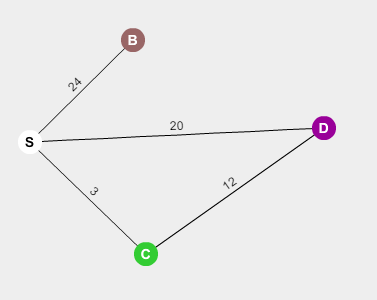
- Dijkstra(BFS + PQ. Works without visited set)
#include <cmath>
#include <cstdio>
#include <vector>
#include <queue>
#include <iostream>
#include <algorithm>
using namespace std;
struct Node {
int id;
unsigned int distance; // dist from starting node
vector<pair<Node*,int>> adjacent; //{next node, length}
Node(int id) : id(id), distance(-1){}
};
int main() {
int t;
scanf("%d", &t);
for (int i = 0; i < t; i++) {
int n, m;
scanf("%d %d", &n, &m);
vector<Node*> nodes(n+1);
for (int i=1;i<n+1;++i) nodes[i]=new Node(i);
for (int j=0;j<m; ++j) {// fill up node info
int x, y, r;
scanf("%d %d %d", &x, &y, &r);
Node *u = nodes[x], *v = nodes[y];
u->adjacent.emplace_back(v, r); // adjacent list
v->adjacent.emplace_back(u, r);
}
int s;
scanf("%d", &s);
priority_queue<pair<int, Node*>> pq;
nodes[s]->distance = 0;
pq.emplace(0, nodes[s]); // dist, node, keyed by distance
while (!pq.empty()) {
const auto d = pq.top().first;
const auto u = pq.top().second;
pq.pop();
if (d > u->distance) { continue; }//
for (const auto &pair : u->adjacent) {
const auto v = pair.first;
const auto e = pair.second;
if (v->distance > d + e) { // relax
v->distance = d + e;
pq.emplace(d + e, v);
}
}
}
bool first = true;
for (int j = 1; j <= n; j++) {
if (j == s) {continue;}
cout << (first ? "" : " ") << (int)nodes[j]->distance;
first = false;
}
cout << endl;
}
return 0;
}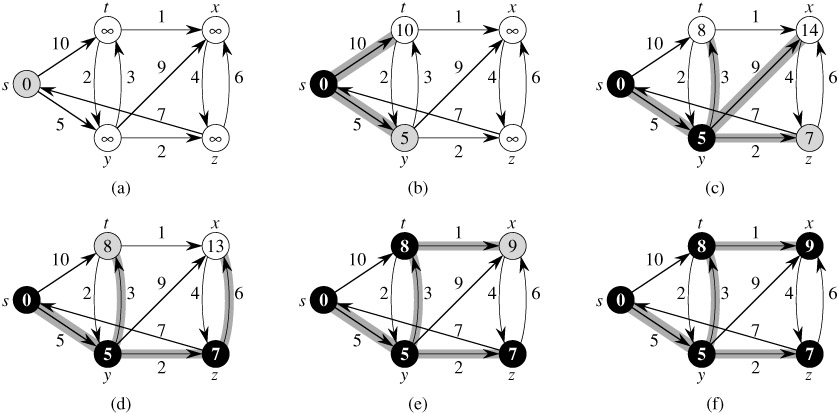
- Dijkstra (BFS+PQ) in implicit Graph with a visited set
#include <vector>
#include <set>
#include <queue>
#include <map>
#define PB push_back
#define F first
#define S second
#define HAS count
#define MP make_pair
#define INT_MAX 2147483647
#define PII pair<int,int>
using namespace std;
int main() {
int n,v,e,x,y,w,s;
scanf("%d\n", &n);
while(n--){
scanf("%d %d\n", &v, &e);
vector<int> ds = vector<int>(v+1,INT_MAX); // distance to s
map<int,map<int,int>> edges; // node->node->weight/cost/length
int m=e;
while(m--){
scanf("%d %d %d\n", &x, &y, &w);
// BUG: dup edges with different weight
if(!edges[x].HAS(y) || edges[x][y]>w)
edges[x][y]=w, edges[y][x]=w;
}
scanf("%d\n", &s); // starting node
ds[s]=0;
priority_queue<PII,vector<PII>,greater<PII>> qq;// min-heap
qq.emplace(0,s); // {distance, node}
set<int> visited;
while(!qq.empty()){
auto t=qq.top(); qq.pop();
if(visited.HAS(t.S)) continue;//
ds[t.S]=t.F;
for(const auto& pr : edges[t.S]){ //{node,len}
int d=t.F+edges[t.S][pr.F];
if(ds[pr.F]>d){ //relax
ds[pr.F]=d, qq.emplace(d, pr.F);////
}
}
visited.insert(t.S);
}
for(int i=1;i<=v;++i)
if(i!=s)printf(i<v?"%d ":"%d\n", ds[i]==INT_MAX?-1:ds[i]);
}
return 0;
}Removing the relax operation in line 38, it also works:
int main() {
int n,v,e,x,y,w,s;
scanf("%d\n", &n);
while(n--){
scanf("%d %d\n", &v, &e);
vector<int> ds = vector<int>(v+1,INT_MAX); // distance to s
map<int,map<int,int>> edges; // node->node->weight/cost/length
int m=e;
while(m--){
scanf("%d %d %d\n", &x, &y, &w);
// BUG: dup edges with different weight
if(!edges[x].HAS(y) || edges[x][y]>w)
edges[x][y]=w, edges[y][x]=w;
}
scanf("%d\n", &s); // starting node
ds[s]=0;
priority_queue<PII,vector<PII>,greater<PII>> qq;
qq.emplace(0,s); // weight and node
set<int> visited;
while(!qq.empty()){
auto t=qq.top(); qq.pop();
if(visited.HAS(t.S)) continue;
ds[t.S] = t.F;
for(const auto& pr : edges[t.S]){ //{node,len}
int d=t.F+edges[t.S][pr.F];
qq.emplace(d, pr.F);
}
visited.insert(t.S);
}
for(int i=1;i<=v;++i)
if(i!=s) printf(i<v?"%d ":"%d\n", ds[i]==INT_MAX?-1:ds[i]);
}
return 0;
}20.28 787. Cheapest Flights Within K Stops
There are n cities connected by m flights. Each fight starts from city u and arrives at v with a price w.
Now given all the cities and fights, together with starting city src and the destination dst, your task is to find the cheapest price from src to dst with up to k stops. If there is no such route, output -1.
Example 1:
Input:
n = 3, edges = [[0,1,100],[1,2,100],[0,2,500]]
src = 0, dst = 2, k = 1
Output: 200Explanation:
The graph looks like this:
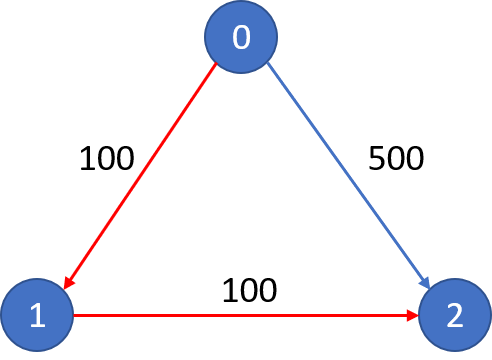
The cheapest price from city 0 to city 2 with at most 1 stop costs 200, as marked red in the picture.
Example 2:
Input:
n = 3, edges = [[0,1,100],[1,2,100],[0,2,500]]
src = 0, dst = 2, k = 0
Output: 500Explanation:
The graph looks like this:
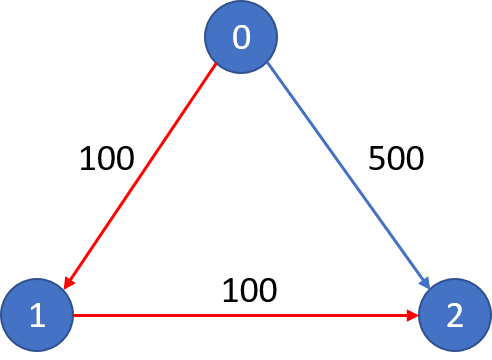
The cheapest price from city 0 to city 2 with at most 0 stop costs 500, as marked blue in the picture.
https://leetcode.com/problems/cheapest-flights-within-k-stops/
这个写法比较特殊:
class Solution {
public:
int findCheapestPrice(int n, vector<vector<int>>& flights, int src, int dst, int K) {
unordered_map<int,unordered_map<int,int>>mp; // a -> b = cost
for(auto& e : flights)
mp[e[0]][e[1]] = e[2];
unordered_map<int,int> cost = mp[src];
while(K--){
unordered_map<int,int> tmp = cost; // cost from starting point
for(pair<int,int>& e : tmp){
unordered_map<int,int>& next = mp[e.first];
for(auto& f : next){
if(cost.count(f.first)){
cost[f.first] = min(cost[f.first], e.second + f.second);
}else{
cost[f.first] = e.second + f.second;
}
}
}
}
return cost.count(dst) ? cost[dst] : -1;
}
};- JAVA
class Solution {
public int findCheapestPrice(int n, int[][] flights, int src, int dst, int K) {
int[][][] graph = new int[n][n][2]; // a,b,weight
for (int[] curr : flights) {
int u = curr[0], v = curr[1], w = curr[2];
graph[u][v][0] = 1;
graph[u][v][1] = w;
}
if (K == 0) {
return (graph[src][dst][0] == 1) ? graph[src][dst][1] : -1;
}
Queue<Integer> q = new LinkedList<>();// what is in the queue
int[] dist = new int[n];
Arrays.fill(dist, Integer.MAX_VALUE);
q.add(src);
dist[src] = 0;
int step = 0;
while (!q.isEmpty()) {
int sz = q.size();
while (sz-- != 0) {
int i = q.poll();
if (step > K) break;
for (int j = 0; j < n; j++) {
if (graph[i][j][0] == 1 && dist[j] > dist[i] + graph[i][j][1]) {
q.add(j);
dist[j] = dist[i] + graph[i][j][1];
}
}
}
step++;
if (step > K)
break;
}
return (dist[dst] != Integer.MAX_VALUE) ? dist[dst] : -1;
}
}20.29 Kruskal (MST): Really Special Subtree
https://www.hackerrank.com/challenges/kruskalmstrsub/problem
#include <map>
#include <vector>
#include <iostream>
using namespace std;
struct KruskalMST{
map<int,map<int,int>> m; // weight, a, b
vector<int> bo;
KruskalMST(int v){ bo.resize(v+1,-1); }
int findbo(int x){ return (bo[x]!=-1)?findbo(bo[x]):x;}
void merge(int x, int y){
if(findbo(x)==findbo(y)) return;
x=findbo(x), y=findbo(y);
bo[x]=y;
}
void addEdge(int x, int y, int w){
m[w][x]=y;
m[w][y]=x;// actually this can be removed
}
int sumOfMST(){
int sum=0;
for(auto& pr: m){
for(auto& e: pr.second){
int x=findbo(e.first),y=findbo(e.second);
if(x==y) continue;
sum+=pr.first;
merge(e.first, e.second);
}
}
return sum;
}
};
int main() {
int v=0, e=0;
cin >> v >> e;
int x,y,r;
KruskalMST mst(v);
for(int i=0;i<e;i++){
cin >> x >> y >> r;
mst.addEdge(x,y,r);
}
cout << mst.sumOfMST() << endl;
return 0;
}20.30 Prim’s (MST) : Special Subtree
https://www.hackerrank.com/challenges/primsmstsub/problem
Note this is an undirected graph.
#include <iostream>
#include <map>
#include <set>
#include <queue>
using namespace std;
#define COST int
int main(int argc, char** argv){
int v=0, e=0, start;
map<int,map<int,int>> m; // a,b,w
cin >> v >> e;
int x,y,z;
for(int i=0;i<e;i++)
cin >> x >> y >> z, m[x][y]=z, m[y][x]=z;
cin>>start;
priority_queue<pair<COST,int>,vector<pair<COST,int>>,greater<pair<COST,int>>> q;
set<int> nodes;
q.emplace(0,start);
int sum=0;
while(!q.empty()){
auto e=q.top(); q.pop(); // {dis,a}
if(nodes.count(e.second)) continue;
sum+=e.first, nodes.insert(e.second);
for(auto& pr: m[e.second])// {b,w}
q.emplace(pr.second, pr.first);
}
cout << sum << endl;
return 0;
}